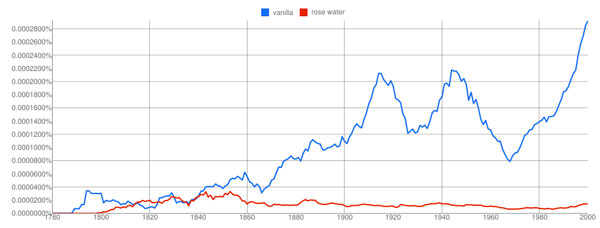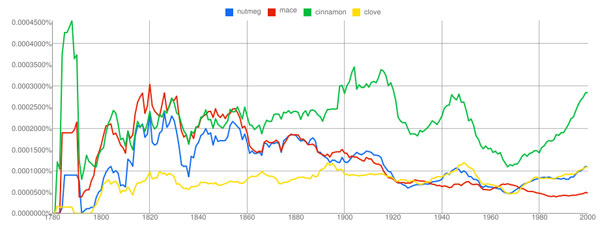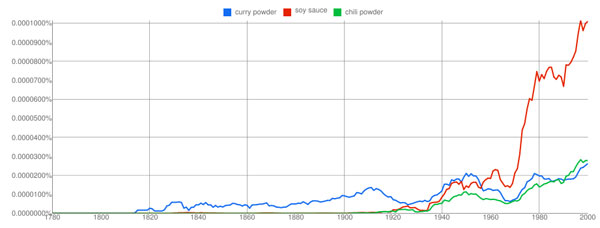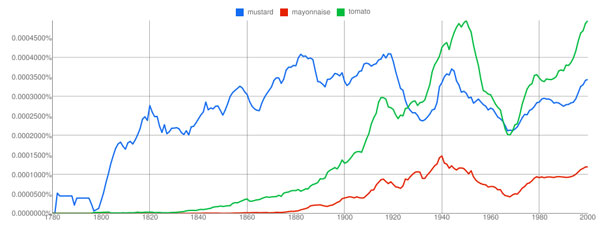Starting Tuesday night, I’m teaching a three-part course on Historic Gastronomy at the Brookyln Brainery. It’s going to involve a lot of history, a lot of nerdery, and a lot of eating. You can read the full course description and sign up here (new spots were recently opened for students due to high demand; at the time of the writing, there were three spots left. Sign up here.)
My first class is called A Timeline of Taste; we’re going to explore the history of American food through flavor: we’ll travel from 1796-1950, making a pit stop every 50 years to explore the tastes of a particular time. Participants will smell and sample the spices, fruits, extracts, and other ingredients that defined the flavors of different time periods. We’ll discuss why each of these flavors were popular and how they were used in day to day cooking.
Many ingredients have a flash point that sends them soaring in popularity, pushing other tastes out of vogue: an increase in production, a decrease in cost, a popular recipe, etc. As I was researching the histories of American ingredients, like rosewater, vanilla, curry and ketchup, I realized the results would be a really cool data visualization project. I wanted to see a timeline of when ingredients were the most popular.
A quick and dirty way to do this is through Google Ngram Viewer, one of the coolest toys on the web. Google says: “When you enter phrases into the Google Books Ngram Viewer, it displays a graph showing how those phrases have occurred in a corpus of books.”
I plugged in search terms, I was astounded by the visualization of the results. You could often see the exact historical moment an ingredient became popular.
For example, from about 1750-1840, rose water was the primary flavoring for cakes and other confections in the United State. While today we associate it with Middle Eastern cuisine, for English colonists it was used as a cheap alternative to vanilla. Vanilla was only grown in Mexico because its pollination was very closely linked to a certain species of Mexican bee. In 1841, a twelve year old slave discovers how to hand pollinate vanilla flowers. Vanilla cultivation is moved outside of Mexico and the product became much cheaper.
Look at the chart above: rose water is more or as popular as vanilla until 1841. Then vanilla takes off while rosewater flat lines.
A few more fun charts are below. We’ll be talking about these ingredients, and so much more, at the Brooklyn Brainery Tuesday night.





Uh oh, all that I do all day is make and look at graphs, my analytical mind is excited by your astonishing graphical format!
Any thoughts on why there’s that spike in the 1780s for nutmeg, mace, cinnamon and clove?
Here’s what I think: the data is based on the percentage of books from a given year, so i think the spike in the 1780s, along with the subsequent dip in the following years, has to do with the amount of cookbooks being published. The first cookbook by an american author was published in 1796; before that, there were a couple English cookbooks printed in America. So if 30 books were published in American in 1780, and one of them is a cookbook that mentions all of those spices, that’s a pretty high ratio.
I should have actually trimmed the data a little bit, and just started at 1796. After that point, there was an explosion in food writing, that allow for more relevant data.
And there’s more accurate ways to do this whole thing; but it is interesting how the number of times something is mentioned in writing reflects the culinary trends of each era.
I was wonderign what the dip accross the board in the early 1960’s about?
That is an interesting observation! And I can only speculate. Did American food really get that bland?
Does the 1780 spike maybe also have to do with the lifting of British trade restrictions (and taxes) on goods- all those smugglers going legitimate?
I don’t think so–because most of the spices don’t become more popular, and more affordable until the 1850s. I really think it’s just an anomaly in the data.
Pingback: Food Links, 20.07.2011 « Tangerine and Cinnamon
Pingback: https://july.co.in